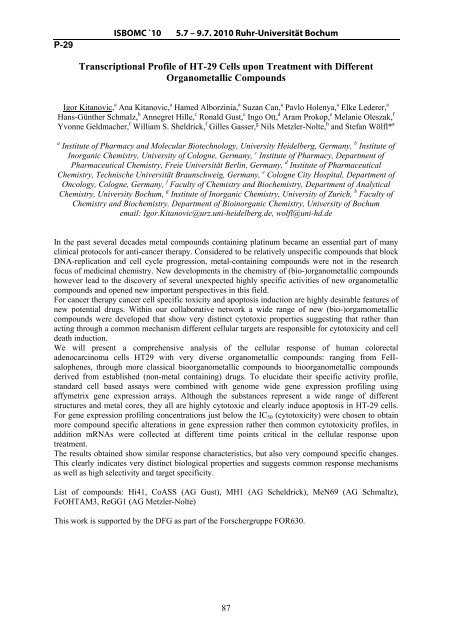Book of Abstracts - Ruhr-Universität Bochum
Book of Abstracts - Ruhr-Universität Bochum
Book of Abstracts - Ruhr-Universität Bochum
You also want an ePaper? Increase the reach of your titles
YUMPU automatically turns print PDFs into web optimized ePapers that Google loves.
P-29<br />
ISBOMC `10 5.7 – 9.7. 2010 <strong>Ruhr</strong>-<strong>Universität</strong> <strong>Bochum</strong><br />
Transcriptional Pr<strong>of</strong>ile <strong>of</strong> HT-29 Cells upon Treatment with Different<br />
Organometallic Compounds<br />
Igor Kitanovic, a Ana Kitanovic, a Hamed Alborzinia, a Suzan Can, a Pavlo Holenya, a Elke Lederer, a<br />
Hans-Günther Schmalz, b Annegret Hille, c Ronald Gust, c Ingo Ott, d Aram Prokop, e Melanie Oleszak, f<br />
Yvonne Geldmacher, f William S. Sheldrick, f Gilles Gasser, g Nils Metzler-Nolte, h and Stefan Wölfl* a<br />
a Institute <strong>of</strong> Pharmacy and Molecular Biotechnology, University Heidelberg, Germany, b Institute <strong>of</strong><br />
Inorganic Chemistry, University <strong>of</strong> Cologne, Germany, c Institute <strong>of</strong> Pharmacy, Department <strong>of</strong><br />
Pharmaceutical Chemistry, Freie <strong>Universität</strong> Berlin, Germany, d Institute <strong>of</strong> Pharmaceutical<br />
Chemistry, Technische <strong>Universität</strong> Braunschweig, Germany, e Cologne City Hospital, Department <strong>of</strong><br />
Oncology, Cologne, Germany, f Faculty <strong>of</strong> Chemistry and Biochemistry, Department <strong>of</strong> Analytical<br />
Chemistry, University <strong>Bochum</strong>, g Institute <strong>of</strong> Inorganic Chemistry, University <strong>of</strong> Zurich, h Faculty <strong>of</strong><br />
Chemistry and Biochemistry, Department <strong>of</strong> Bioinorganic Chemistry, University <strong>of</strong> <strong>Bochum</strong><br />
email: Igor.Kitanovic@urz.uni-heidelberg.de, wolfl@uni-hd.de<br />
In the past several decades metal compounds containing platinum became an essential part <strong>of</strong> many<br />
clinical protocols for anti-cancer therapy. Considered to be relatively unspecific compounds that block<br />
DNA-replication and cell cycle progression, metal-containing compounds were not in the research<br />
focus <strong>of</strong> medicinal chemistry. New developments in the chemistry <strong>of</strong> (bio-)organometallic compounds<br />
however lead to the discovery <strong>of</strong> several unexpected highly specific activities <strong>of</strong> new organometallic<br />
compounds and opened new important perspectives in this field.<br />
For cancer therapy cancer cell specific toxicity and apoptosis induction are highly desirable features <strong>of</strong><br />
new potential drugs. Within our collaborative network a wide range <strong>of</strong> new (bio-)orgamometallic<br />
compounds were developed that show very distinct cytotoxic properties suggesting that rather than<br />
acting through a common mechanism different cellular targets are responsible for cytotoxicity and cell<br />
death induction.<br />
We will present a comprehensive analysis <strong>of</strong> the cellular response <strong>of</strong> human colorectal<br />
adenocarcinoma cells HT29 with very diverse organometallic compounds: ranging from FeIIsalophenes,<br />
through more classical bioorganometallic compounds to bioorganometallic compounds<br />
derived from established (non-metal containing) drugs. To elucidate their specific activity pr<strong>of</strong>ile,<br />
standard cell based assays were combined with genome wide gene expression pr<strong>of</strong>iling using<br />
affymetrix gene expression arrays. Although the substances represent a wide range <strong>of</strong> different<br />
structures and metal cores, they all are highly cytotoxic and clearly induce apoptosis in HT-29 cells.<br />
For gene expression pr<strong>of</strong>iling concentrations just below the IC50 (cytotoxicity) were chosen to obtain<br />
more compound specific alterations in gene expression rather then common cytotoxicity pr<strong>of</strong>iles, in<br />
addition mRNAs were collected at different time points critical in the cellular response upon<br />
treatment.<br />
The results obtained show similar response characteristics, but also very compound specific changes.<br />
This clearly indicates very distinct biological properties and suggests common response mechanisms<br />
as well as high selectivity and target specificity.<br />
List <strong>of</strong> compounds: Hi41, CoASS (AG Gust), MH1 (AG Scheldrick), MeN69 (AG Schmaltz),<br />
FcOHTAM3, ReGG1 (AG Metzler-Nolte)<br />
This work is supported by the DFG as part <strong>of</strong> the Forschergruppe FOR630.<br />
87
















